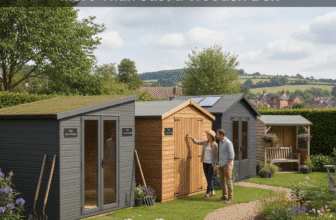
Buying Your Own Slice of Heaven: A Guide to Woodland for Sale in the UK
The dream of owning your own woodland is more attainable than you might think. Whether you picture a tranquil retreat, a haven for wildlife, or a long-term investment, purchasing a piece of woodland in the UK can be a rewarding experience. This guide will walk you through the process, exploring the benefits, considerations, and practical steps involved in buying woodland.
Why Buy Woodland?
The reasons for buying woodland are as diverse as the woodlands themselves. Some common motivations include:
- Conservation: Owning woodland allows you to actively participate in conservation efforts, protecting biodiversity and creating habitats for native flora and fauna.
- Recreation: Imagine having your own private space for walking, camping, wildlife observation, or simply escaping the hustle and bustle of everyday life.
- Investment: Woodland can be a sound long-term investment. Timber prices fluctuate, but the underlying value of land tends to appreciate over time. Certain types of woodland may also qualify for tax benefits.
- Sustainable Living: Woodland can provide a source of firewood, reducing your reliance on fossil fuels. It can also be a place to practice sustainable forestry techniques.
- Personal Well-being: Spending time in nature has proven benefits for mental and physical health. Owning woodland provides a readily accessible sanctuary.
- Legacy: Leaving woodland for next generations.
Types of Woodland for Sale
The UK boasts a wide variety of woodland types, each with its own unique characteristics:
- Ancient Woodland: These woodlands have been continuously wooded since at least 1600 AD. They are incredibly rich in biodiversity and often contain rare or protected species. Ancient woodlands are highly valued and strictly protected.
- Semi-Natural Ancient Woodland: These are ancient woodlands that have been altered by human activity, such as coppicing or planting, but still retain many of their original characteristics.

- Planted Ancient Woodland Sites (PAWS): These are ancient woodland sites that have been replanted with non-native tree species, often conifers. Restoring PAWS to their native broadleaf composition is a common conservation goal.
- Coniferous Woodland: These woodlands are dominated by conifer trees, such as Sitka spruce, Douglas fir, and Scots pine. They are often managed for timber production.
- Broadleaf Woodland: These woodlands are composed primarily of broadleaf trees, such as oak, beech, ash, and birch. They tend to be more biodiverse than coniferous woodlands.
- Mixed Woodland: As the name suggests, these woodlands contain a mixture of both conifer and broadleaf trees.
- Coppice Woodland: Coppicing is a traditional woodland management technique that involves cutting trees down to ground level to encourage regrowth.
Finding Woodland for Sale
Several avenues exist for finding woodland for sale in the UK:
- Specialist Woodland Agents: Several estate agents specialize in the sale of woodland. They often have extensive listings and can provide expert advice.
- Online Property Portals: While less common, some general property portals may list woodland for sale.
- Land Auctions: Woodland is occasionally sold at auction, which can be an opportunity to secure a bargain, but requires careful preparation and research.
- Local Contacts: Networking with local landowners, farmers, and forestry professionals can sometimes uncover off-market opportunities.
Things to Consider Before Buying
Before taking the plunge, consider these crucial factors:
- Location: Proximity to your home, accessibility, and local amenities are important considerations.
- Size: Woodland sizes vary greatly, from small plots to extensive forests. Consider your budget and intended use when determining the appropriate size.
- Access: Ensure there is legal right of access to the woodland, including vehicular access if required.
- Boundaries: Clearly defined boundaries are essential to avoid disputes with neighboring landowners.
- Tree Species and Condition: The type and condition of the trees will influence the woodland’s value, management requirements, and potential uses.
- Wildlife and Habitats: Consider the presence of any protected species or habitats, which may impose restrictions on management activities.
- Planning Permission: If you intend to build any structures, even temporary ones, you will likely need planning permission.
- Management Plan: Developing a long-term management plan is crucial for ensuring the health and sustainability of your woodland.
- Legal Costs: Factor in the costs of conveyancing, surveys, and other legal fees.
- Ongoing costs: Remember to account ongoing costs.
- Topography: The terrain of the land, whether it’s flat, sloped, or hilly.
- Soil Type: Different soil types support different tree species and plant life.
- Water Sources: The presence of streams, ponds, or springs.
The Buying Process
The process of buying woodland is similar to buying any other property:
- Find a suitable woodland: Use online resources, estate agents and your connections.
- View the woodland: Arrange a viewing to see the place.
- Make an offer: If you like place, make an offer to the seller.
- Instruct a solicitor: Once your offer is accepted, instruct a solicitor to handle the legal aspects of the purchase.
- Surveys and Searches: Your solicitor will arrange for necessary surveys and searches, including checks for any legal restrictions or environmental issues.
- Exchange Contracts: Once all surveys and searches are complete, you will exchange contracts with the seller, making the purchase legally binding.
- Completion: On the agreed completion date, the funds will be transferred, and you will become the legal owner of the woodland.
Enjoying Your Woodland
Owning woodland is a unique and rewarding experience. Whether you choose to actively manage it, simply enjoy its tranquility, or pursue a combination of both, your woodland will provide years of enjoyment and a lasting connection to nature.







